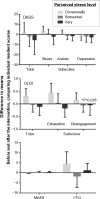Stress and burnout in residents: impact of mindfulness-based resilience training
- PMID: 26347361
- PMCID: PMC4554415
- DOI: 10.2147/AMEP.S88580
Stress and burnout in residents: impact of mindfulness-based resilience training
Abstract
Background and objective: Stress and burnout impact resident physicians. This prospective study tests the hypothesis that a mindfulness-based resilience intervention would decrease stress and burnout in residents.
Methods: Resident physicians from the Departments of Family Medicine, Psychiatry, and Anesthesia at Duke University, Durham, NC, USA, participated in two or three 1-hour sessions of mindfulness-based resilience activities, which introduced mindful-awareness and included practical exercises for nurturing resilience. Anonymous surveys were distributed before (completed by 47 residents) and after the intervention (both completed by 30 residents); a follow-up survey was distributed 1 month later (seven residents completed all three surveys). The survey included the Depression Anxiety Stress Scale, 21-question version (DASS-21), the Oldenburg Burnout Inventory, the Mindful Attention Awareness Scale, and ten questions from the Cognitive Failures Questionnaire.
Results: At baseline, most residents' scores were in the normal range with respect to stress; however, female residents had higher DASS-21 scores than male residents (31.7, females vs 18.4, males; P=0.002). Most residents' burnout scores were in the abnormal range, both with respect to exhaustion (38/47 residents, subscore ≥2.25) and disengagement (37/47 residents, subscore ≥2.1). Higher perceived levels of stress correlated with the instruments. Analysis of the surveys before and after the intervention showed no significant short-term change in stress, burnout, mindful-awareness, or cognitive failure. There was a trend for females and post-medical school graduate year 1 and 2 (PGY1 and PGY2) residents to have a reduction in DASS-21 scores after intervention. There was also a trend of reduced stress and burnout in residents who perceived higher stress.
Conclusion: Residents who are female, PGY1 and PGY2, and who perceive residency to be stressful may benefit most from a mindfulness-based resilience intervention.
Keywords: medical trainees; physician; self-care; wellness.
Figures



References
-
- Resident Services Committee, Association of Program Directors in Internal Medicine Stress and impairment during residency training: strategies for reduction, identification, and management. Ann Intern Med. 1988;109(2):154–161. - PubMed
-
- Levey RE. Sources of stress for residents and recommendations for programs to assist them. Acad Med. 2001;76(2):142–150. - PubMed
-
- Thomas NK. Resident burnout. JAMA. 2004;292(23):2880–2889. - PubMed
-
- Schaufeli WB, Buunk BP. Professional burnout. In: Schabracq MJ, Winnubst JAM, Cooper CL, editors. Handbook of Work and Health Psychology. New York: Wiley; 1996. pp. 513–527.
-
- Maslach C, Jackson SE. Maslach Burnout Inventory: Manual Research Edition. Palo Alto: Consulting Psychologists Press; 1986.
LinkOut - more resources
Full Text Sources
Medical

